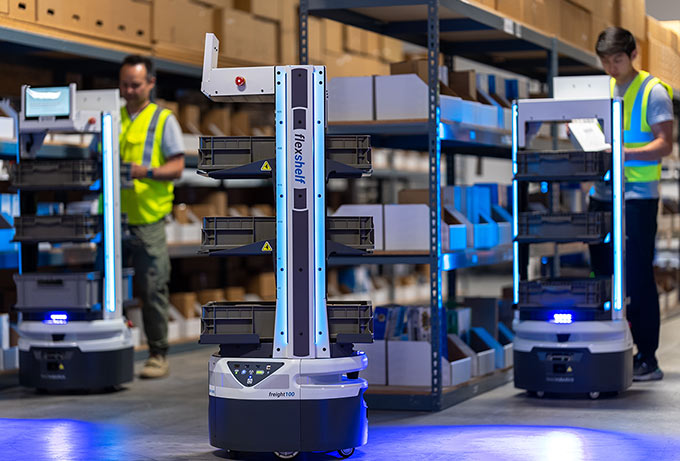Coming out of the COVID pandemic, we’ve seen how many industries were exposed to supply chain bottlenecks and increased air freight usage; it’s not until recently that we’ve returned to something that resembles typical economic ordering cycles.
We recently spoke with the strategy lead for transport and logistics at Zebra Technologies to discuss the challenges and trends in supply chain management in 2024 and beyond, both as a provider of solutions and as an operator of their supply chain. (view the interview here)
Key trends for 2024 that the conversation covered include:
- Labor shortages and increased labor costs
- Companies are driven to mechanize and automate tasks
- Companies are making work more meaningful for employees

Investments in robotics and artificial intelligence (AI)
The demand for faster throughput and immediate fulfillment is rising, leading to robotics and artificial intelligence investments.
As a result, the industry is shifting from descriptive analytics to predictive and prescriptive analytics, utilizing AI to optimize workflows and determine the subsequent best actions. While these trends are already underway, experts believe there is still much potential in robotics and artificial intelligence to revolutionize supply chain management further.

Companies are increasing investments in robotics, aiming to support customers with material movement and picking use cases, making jobs faster and easier. Orchestration is also an emerging trend, as multiple robots from different providers need to be integrated seamlessly for optimal value.
While consumer-facing AI applications are interesting, the industrial side of AI is expected to have a more significant and rapid impact on optimization. For instance, rerouting trucks based on temperature changes or sending notifications for truck arrivals can be improved with AI-driven automation.
In the future, robotics will advance, tackling more complex tasks like unloading trucks or inventory management. The combination of technologies on a single robot will also increase, providing new automation solutions. This ongoing robotics revolution will continue to make jobs more efficient and enriching for workers.
This ongoing robotics revolution will continue to make jobs more efficient and enriching for workers.
Combining Warehouse Technologies
In addition to robotics, integrating various technologies such as RFID, computer vision, and smart sensors is expected to grow in importance in the coming years. The experts predict that there won’t be a one-size-fits-all solution but a combination of these technologies to capture data faster, more accurately, and in a more effortless manner.
RFID is expected to continue growing as the cost of infrastructure and tags drops. Large retailers are also implementing new regulations that require better visibility and traceability in the supply chain, which will drive the adoption of RFID technology.
Vision technology, which includes machine vision and computer vision, is also predicted to play a significant role in the future, with use cases such as parcel identification and pallet verification. Data processing for vision technology is yet to be determined, but it will depend on the specific use case and requirements.
Handheld RFID scanners and fixed RFID readers will coexist based on different use cases. The experts are optimistic about the proliferation of smart sensors, driven by demands for tracking conditions in addition to location and new regulations.
Summary
Warehouse and supply chain technologies will have the most significant impact in the next few years. Robotics and AI are expected to continue growing in the industrial sector, while vision technology will become more prominent in various aspects of the supply chain. The future will also see more granular and real-time data, allowing for better decision-making and optimization.
The integration of multiple technologies like robotics, RFID, computer vision, and smart-sensors will mark the future of warehouse technology.
The integration of multiple technologies like robotics, RFID, computer vision, and smart-sensors will mark the future of warehouse technology.
The experts believe that this combinatorial approach will help capture data faster and more accurately, addressing various challenges in the supply chain. Robotics, AI, and vision technology will play significant roles in driving these changes, with more granular and real-time data enabling better decision-making and optimization in the industry.
If you would like to listen to the full podcast, click here.
For other sessions and more content like this, subscribe to the BlueFletch YouTube channel.
